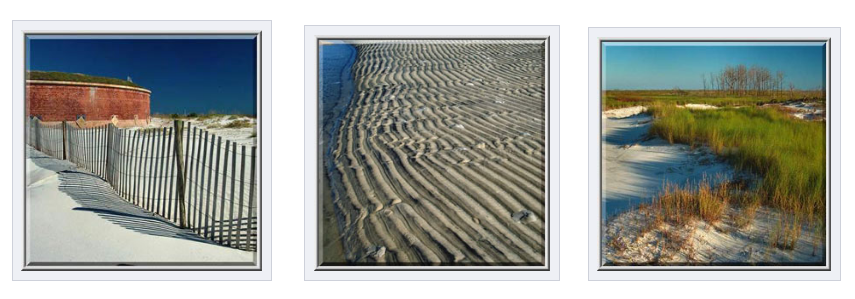The marine wildlife and environmental guidelines below are intended to help you enjoy watching marine wildlife without causing them harm or disturbing the environment. Please note that these are general guidelines and that the types of wildlife, local habitat conditions, and numbers of people present in an area may require restrictions to protect the wildlife and cultural resources. Always follow park rules and regulation and species-specific guidelines and regulations when available, and respect the rights of all wildlife while visiting Ship Island. Click HERE to Download a Flyer
Help Us Reduce Single Use Plastic
Please help us reduce “single use plastics” when packing for your day at Ship Island by following these guidelines:
- Reduce single use bottles by pouring them into a reusable container (Juice & Water)
- Use can soft drinks & beer cans and recycle (Recycle Bins are located on the boat and island)
- Use paper cups instead of plastic cups.
- Do not bring plastic straws of any kind.

ENVIRONMENTAL GUIDELINES
1. Learn before you go. Read about the wildlife and history of Ship Island and National Seashore regulations to get the most from your island visit. Many species live only in specific habitats such as estuaries, beaches, sand dunes or the open Gulf. Seasonal and daily cycles also influence when and where an animal may be located. Research on the internet, buy regional viewing guidebooks, talk with our staff and park rangers to increase your chances of seeing marine wildlife.
2. Keep your distance. Use binoculars, spotting scopes and cameras with zoom lenses to get a closer look. Avoid nesting shore birds and sea turtle areas. Marine wildlife may be very sensitive to human disturbance, and if encountered, they can harm the viewer or leave the area. If wildlife approaches you, stay calm and slowly back away. When closer encounters occur, do not make sudden moves or obstruct the travel path of the animals – let them have the unhindered “right of way.” Alligators are common on the barrier islands. Fun to watch, but please keep you distance and do not disturb the animal.
3. Hands off. Never touch, handle marine wildlife or plants. Touching wildlife, or attempting to do so, can injure the animal, put you at risk and may also be illegal for certain species. The slimy coating on fish and many marine invertebrates protects the animal from infection and is easily rubbed off with a hand, glove or foot. Avoid using gloves when diving or
snorkeling to minimize the temptation to touch. Remember, wild animals may bite, sting or even pull you underwater if startled or threatened. Stay off of sand dunes and beach vegetation. Do not pick seaoats or wild flowers.
4. Do not feed or attract marine wildlife. Feeding or attempting to attract wildlife with food, decoys, sound or light disrupts normal feeding cycles, may cause sickness or death from unnatural or contaminated food items, and habituates animals to people. Habituated animals are vulnerable to vessel strikes or vandalism, and can be dangerous to people. Do not feed seagulls or other birds.
5. Never chase or harass wildlife. Following a wild animal that is trying to escape is dangerous. Never completely surround the animal, trap an animal between a vessel or shore, block its escape route, or come between mother and young.
6. Stay away from wildlife that appears distressed. Some marine animals such as turtles, leave the water or are exposed at low tide as part of their natural life cycle — there may be nothing wrong with them. Young animals that appear to be orphaned may actually be under the watchful eye of a nearby parent. An animal that is sick or injured is already vulnerable and may be more likely to bite. If you think an animal is in trouble, contact the local authorities for advice.
7. Wildlife and pets don’t mix. Wild animals can injure and spread diseases to pets, and in turn, pets can harm and disturb wildlife. For example, wild animals recognize dogs as predators and quickly flee when they see or smell dogs. If you are traveling with a pet, always keep them on a leash and away from areas frequented by marine wildlife.
8. Lend a hand with trash removal. Human garbage is one of the greatest threats to marine wildlife. Carry a trash bag with you and pick up litter found along the shore and in the water. Plastic bags, floating debris and monofilament line pose the greatest risk to wildlife. Help the National Park Service by packing out whatever you pack on to the island.
9. Help others to become responsible wildlife watchers and tour operators. Speak up if you notice other viewers or tour operators behaving in a way that disturbs the wildlife or other viewers, or impacts sensitive habitats. Be friendly, respectful and discrete when approaching others. When operating a boat, lead by example and reduce your speed in areas frequented by marine wildlife, anchor properly and encourage others to do the same. Violations of the law should be reported to local authorities.”
Protecting Cultural Resources
A goal of Pan Isles Inc. is to insure that all waste material accumulated is properly collected and disposed. Garbage collection stations are located at the dock, on vessels, and at the entry to the Ship Island South Beach swimming area. Please help us protect Ship Island by disposing of your trash responsibly. We also strongly encourage recycling to reduce waste. Recycle bins are located on the vessels and in the snack bar. Beach employees offer litter bags to all visitors on the south beach swim area throughout the day, and directs visitors to available trash containers.
Protection of Soundscape
Protection of natural soundscapes and natural quiet has been increasingly recognized as an aspect of protection of Park resources. Pan Isles is fully committed to this goal. We ask visitors to limit any radios and portable electronics to a minimum volume at all times, or use head phone. Fireworks or noise makers are not permitted on the vessel or island.
Protecting Fort Massachusetts
When you arrive at Ship Island, park rangers generally provide tours of Fort Massachusetts. The tour last about 30 minutes, and it is highly recommended by Pan Isles staff to visitors. While in the fort we ask you obey the rules and signage posted throughout the fort. Please monitor children at all times. Please leave food, drinks and luggage outside the fort in the designated area set aside by the park rangers. Self guided tour material is available upon request.
